TCFD

Introduction
The World Economic Forum’s Global Risks Report explicitly lists climate change as one of the leading threats to the planet The planet has taken measure to curb the impact of climate change, based on the 2015 Paris Agreement adopted at COP21, and now Japan along with over 140 countries and regions have declared their commitment to carbon neutrality by 2050.
The CCBJH Group considers climate change as one of the most important issues we face as a society, and in 2021 we updated our greenhouse gas (GHG) reduction targets to aim for a 50% reduction of Scope 1 and 2 emissions, and a 30% reduction of Scope 3 by 2030 (compared to 2015). We also aim to achieve carbon neutrality by 2050.
In February 2022 we endorsed the Task Force on Climate-related Financial Disclosures (TCFD) recommendations. Furthermore, we have participated in the TCFD Consortium and Climate Change Initiative. In 2023, we have joined GX league. We continue to take action to reduce GHG emissions.
In 2022, a scenario analysis was conducted from a medium-term perspective (2030), covering mainly items of high importance, and in 2023, a scenario analysis was conducted for a longer term (2050), expanding the items covered, and updated accordingly.

Governance
We established a Sustainability Committee to strengthen the system for developing policies and strategies related to various issues including climate change and biodiversity, as a non-financial target, based on the common sustainability framework of the Coca-Cola system in Japan.
Since its creation in 2021, our TCFD working group has focused on mitigating the impact of climate change. By January 2023 a new sustainability committee will be established to formulate policies and strategies on sustainability issues that includes climate change.
The committee is primarily composed of the Executive Leadership Team (ELT)* members and, depending on the agenda, function heads, other executives and staff may also participate in the meeting. It is chaired by the CEO, Calin Dragan, who is also Chairman of the Board of Directors. It is supported by the Sustainability Strategy Division. The committee meets four time a year and reports to the board of directors with feedback on all functions. In 2023, items such as environmental action plans, TCFD disclosures were discussed.
The board of directors oversees risk management processes including our response to climate change. When formulating management policies in the context of business risk appetite and growth, we take such processes into account. In addition to regular discussions by the management team, the board of directors evaluates climate change mitigation initiatives, incorporating them into annual and mid・term business plans. Furthermore, we explain impact of our ESG-related initiatives to external stakeholders at financial results briefings.
* ELT is the management organization of the entire CCBJH Group, including the CEO and each head

Strategy
Our risk analysis has identified climate change as one of the most critical issues to be addressed. We have formulated mitigation plans to respond to the identified risks and opportunities. We determined that a detailed analysis of climate change was needed. In 2023, the target year was expanded to 2030 and 2050, and the quantitative analysis was re-examined and key risks and opportunities were re-identified, including items that were deemed immaterial and excluded from the analysis in 2021. This work was achieved by the TCFD Working Group in cooperation with the board of directors and each business unit from 2021 onwards.
Analysis was conducted for both scenarios (A 1.5°C/2°C and 4°C in global temperatures) as they would affect the beverage business, our primary business segment.
The worldviews and reference scenarios for each temperature range assumed in the study are shown in the table below. In disclosing the impact, we only include the years 2030/2050 for those cases where we believe we can estimate the impact with a relatively high degree of certainty.
| 1.5/2℃ | 4℃ | |
|---|---|---|
| Scenario | Climate change response progresses, intensifying the risk of regulatory and other transitions. Society where social changes associated with the transition to a decarbonized society are likely to affect business |
Climate change response stalls, natural disasters and other physical risks intensify Society in which rising temperatures and other climate changes are likely to affect business |
| Reference | IEA: NZE, SDS IPCC: RCP1.9, 2.6, 4.5 |
IEA: STEPS IPCC: RCP8.5 |
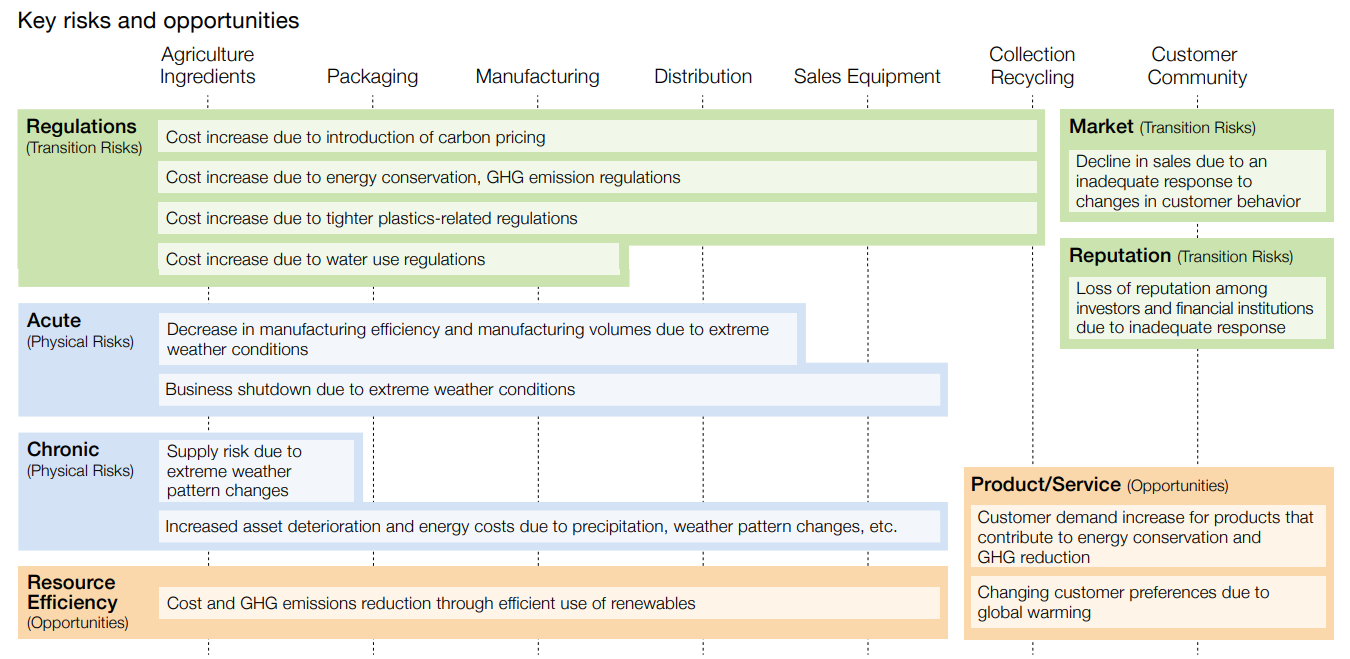
Transition Risks
| Definition | |||
|---|---|---|---|
| Impact | High: 10B YEN + Middle: 1-10B YEN Low: below 1B YEN |
Time of occurrence | Short: Possible to occur by 2025 Mid: Possible to occur by 2030 Long: Possible to occur by 2050 |
| Transition risks of high importance | Details | Impact | Time of occurrence |
Main mitigation plans |
|---|---|---|---|---|
| Cost increase due to introduction of carbon pricing | ■ Cost increase due to introduction of carbon tax and strengthening of emissions trading system, etc. ■ Increased costs due to price shifting of carbon tax at suppliers |
Medium 2030 2050 |
Mid・long-term | ■ Active adoption of recycled materials, promotion of weight reduction ■ Reduction of raw material consumption through lighter containers/packages, etc. |
| Cost increase due to energy conservation and GHG emission regulations | ■ Cost increase due to capital investment for energy conservation and renewable energy, etc. ■ Increased procurement costs due to increased production costs at suppliers |
Medium | Mid・long-term | ■ Reduce dependence on external power supply by introducing renewable energy ■ Shift to use of alternative raw materials (in collaboration with Coca-Cola Japan) |
| Decline in sales due to an inadequate response to changes in customer behavior | ■ Decrease in sales due to shelf drop and customer defection from retailers, etc. | Medium | Short・Mid | ■ Expansion of products in accordance with sustainable procurement ■ Promote environmentally friendly products (e.g., 100% recycled PET/labelless) |
| Cost increase due to tighter plastics-related regulations | ■ Increase in procurement costs for recycled PET resin, etc. | Medium | Mid・long-term | ■ Shift to use of alternative materials active use of recycled materials ■ Promote lighter containers |
| Loss of reputation among investors and financial institutions due to inadequate response | ■ Decrease in stock price and increase in financing costs in case of inadequate response | Low | Short・Mid | ■ SBT certification and participation in RE100 (Under consideration) ■ Proactive and continuous disclosure and dissemination of information based on TCFD・TNFD-related and other factors |
Examples of mitigation plans in action
Reducing plastic waste
Since the 1970s, the Coca-Cola system has worked to reduce the weight of packaging and containers to reduce plastic used and make efficient use of our finite resources. Since spring 2021, Coca-Cola 700ml PET bottles have been reduced in weight from 42g to 27g.
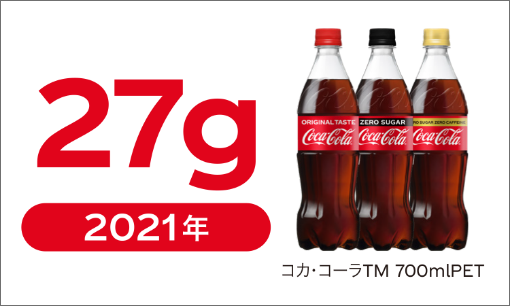
Establishment of "CAN to CAN" system
In collaboration with Artemira Co., Ltd. and MA Aluminum Corporation, the company has kicked off the production of three products using 100% recycled aluminum materials including CAN to CAN as raw materials for the bottle can body, as part of the CAN to CAN horizontal recycling initiative of aluminum cans, in which used aluminum cans are collected from recycling boxes placed next to vending machines operated by CCBJI.

Physical Risks
| Physical risks of high importance | Details | Impact | Time of occurrence |
Main mitigation plans |
|---|---|---|---|---|
| Decrease in manufacturing efficiency and manufacturing volumes due to extreme weather conditions | ■ Increased quality maintenance costs due to deteriorating water quality ■ Increased response costs due to increased risk of illness |
Low | Mid・long-term | ■ Strengthening of BCP response |
| Business shutdown due to extreme weather conditions | ■ Impact of restoration cost and lost sales due to shutdown of factories and other company-owned facilities due to hazardous weather conditions | Medium | Short・Mid | ■ Identify and prioritize wind and flood risks in manufacturing sites, sales/distribution sites, and supply chain, and enhance mitigation plans |
| Scarcity of water-based materials | ■ Increased procurement costs due to soaring water prices ■ Response costs and lost sales due to plant shutdowns caused by drought |
Low | Mid・long-term | ■ Improvement of WUR (*1) ■ Strengthening of S&OP (*2) response |
| Raw material procurement risk due to extreme weather conditions | ■ Increase in procurement costs of agricultural produce and other raw materials | Medium | Short・Mid | ■ Diversification of procurement sources ■ Collaboration with suppliers (e.g., development of agricultural methods) |
*1 WUR(Water Use Ratio)
*2 S&OP(Sales and Operations Integration)
Examples of mitigation plans in action
Shifting to renewable energy
Since 2019, we have adopted the Yamanashi Power Plus "Furusato Hydro Plan", co-brand with Yamanashi Prefecture and Tokyo Electric Power Energy Partners, Inc. So CO2 emissions from electricity use at Hakushu plant are reduced to zero.
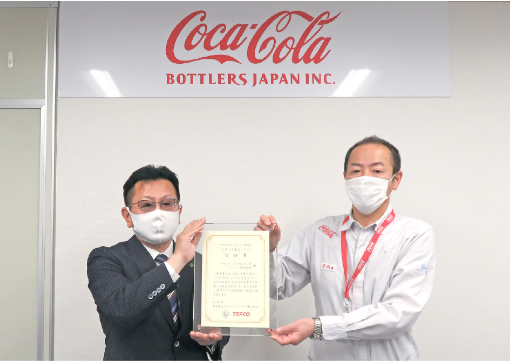
Opportunities
To minimize risks and maximize opportunities under multiple scenarios, we will reflect measures studied in our management strategy and mid・term plan and incorporate them into our annual plan.
In the future, we will continue to expand and refine the scope of disclosure of analysis results, including quantitative results, and periodically review our scenario analysis in response to social trends.
| Opportunities of high importance | Details | Impact | Time of occurrence |
Main mitigation plans |
|---|---|---|---|---|
| Customer demand increase for products that contribute to energy conservation and GHG reduction | ■ Increase in sales due to environmentally friendly raw materials and packaging | Medium | Mid・long-term | ■ Develop and expand environmentally friendly products (e.g., 100% recycled PET bottle, labelless, reusable, package-less) |
| Cost reduction through efficient supply chain | ■ Reduction of electricity costs and GHG emissions by introducing renewable energy and energy-saving equipment ■ Cost reduction through enhanced water efficiency |
Medium | Mid・long-term | ■ Installation of manufacturing equipment equipped with the latest technology, Continuous improvement of manufacturing processes and plant equipment through monitoring ■ Further promotion of water source replenishment capacity improvement |
| Changing customer preferences due to global warming | ■ Increase in sales of heat stroke prevention and healthy beverages | Low | Mid・long-term | ■ Develop and promote heat stroke prevention and healthy beverage products |
Examples of mitigation plans in action
Introduction of 100% recycled PET bottles
100% recycled PET bottles have been introduced for Coca-Cola and other flagship products (38 products from 4 brands).
※As of December 2023.

Introduction of label-less products
Starting with I LOHAS products released in April 2020, currently manufacture 59 labelless products across 8 brands, including “Ayataka,” “Sokenbicha,” “THE TANSAN STRONG From Canada Dry,” “Aquarius,” “Coca-Cola,” “Georgia.” We plan to steadily expand our range of labelless products in the future.
※As of December 2023.
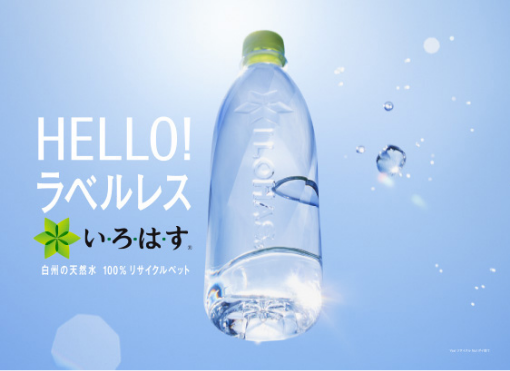
Roadmap for de-carbonization for 2030
We will achieve our 2030 GHG reduction target through the implementation of the following actions. Although it is difficult to clearly foresee the status of infrastructure and technology development over the medium to long term, we will consider and implement appropriate measures for our company through research and other means.
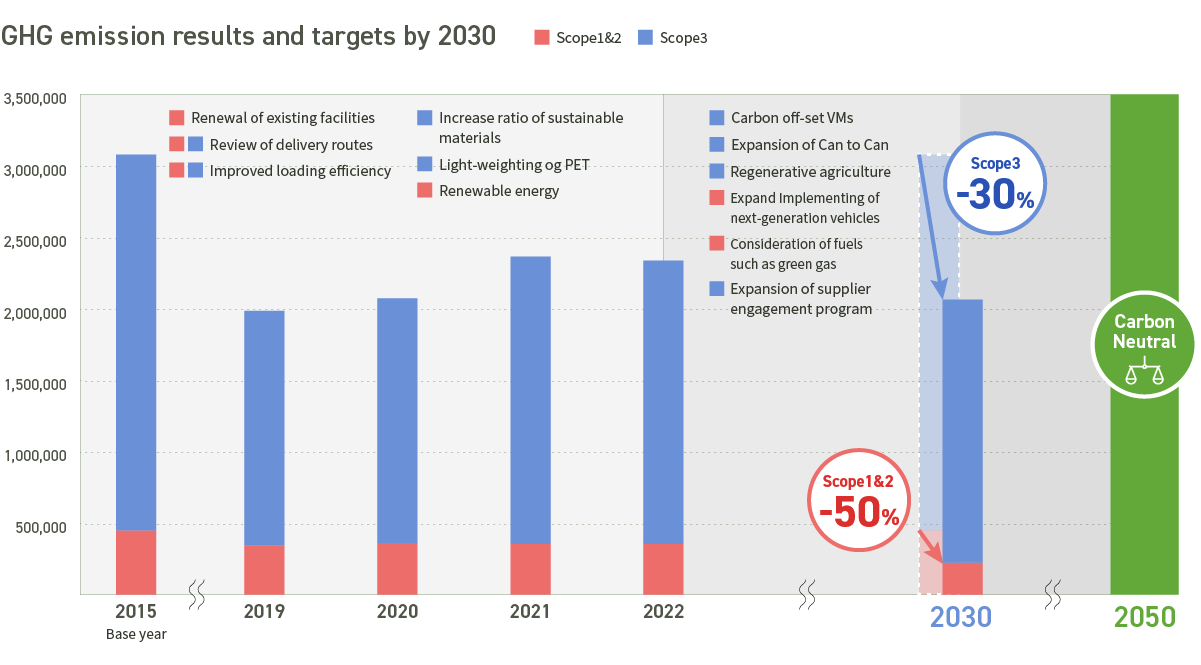
Risk Management
Risk Management System (as of January 2022)

We have implemented a business resilience program that includes Enterprise Risk Management (ERM), that enables us to manage risks and opportunities. The program includes preventive and reactive activities that support business growth while responding to and recovering from adverse events. Our ERM program considers the full range of risks, including the areas of climate change and sustainability.
Our ERM program is aligned with the COSO framework and provides a comprehensive structure for identifying risks and opportunities, developing responses, and making timely and appropriate decisions to support sustainable business growth. The ERM Department implements processes to improve management's involvement in ERM. Regular departmental risk review sessions are held, and the department works closely with departmental risk owners to assess and manage business risks.
In 2022, we established a Risk Management Forum to continuously strengthen our risk management process. The Forum is comprised of senior management members drawn from all divisions, meeting on a quarterly basis. ELT meets every week to analyze and discuss risk. Furthermore, ERM reports to the ELT on Forum discussions, allowing the ELT to analyze risks and opportunities in detail on a quarterly basis.
Under this risk management framework, risks that could have a significant impact on our financial position are identified in terms of likelihood and impact. Therefore, climate change is considered one of the major risks. We believe that a detailed analysis is necessary regarding climate change and so in 2022 and 2023 we conducted a scenario analysis on climate change risks to evaluate their impact. Transition risks (policy, reputation, technology, market), physical risks (acute, chronic), and opportunities (products and services, markets, energy sources, resource efficiency, resilience) are identified and prioritized based on likelihood of occurrence and impact when they occur.
Metrics & Targets
We have set the goal of becoming carbon neutral by 2050 and have established a mid・term target to reduce GHG emissions across the entire value chain in Japan by 50% in Scope 1 and 2 and by 30% in Scope 3 by 2030 compared to 2015*. In this context, we will promote renewable energy. In addition, we have established and are working on the following targets related to packaging containers, water, and other resources.
For more information on greenhouse gas emissions (by category, etc.), please click here.
We have already set indicators and targets for some of the risks derived from the scenario analysis and are making solid progress. In the future, through periodic review of the scenario analysis, we will consider the indicators and targets that will address the opportunities and risks. To achieve our targets, we see cost reductions through energy efficiency as one such opportunity, and we intend to be proactive, for example, by promoting the introduction and use of renewable energy sources.
* Calculated based on GHG Protocol. Reduction targets are based on absolute amounts.

| Key Issues | Category | Target (※3) |
2023 Results (※4) |
Progress |
|---|---|---|---|---|
| World Without Waste (Zero-Waste Society) |
Sustainable materials(※1) usage by 2030 | 100% | 42% | |
| Ratio of products using sustainable materials(※1) by 2025 (number of bottles sold) | 100% | 80%+ | ||
| Further lightweight PET packaging by 2030 (compared to 2004) | 35% | 30%+ | ||
| Collection percentage compared to sales volume by 2030 | 100% | 94.4% (※2) | ||
| Extensive partnerships across industry and environmental organizations by 2030 | - | - | - | |
| Water | Replenishment rate, focusing on watersheds near our plants | 200% | 411% | |
| Water usage reduction by 2030 | 30% | 20% | ||
| Climate change | Scope 1 and 2 reduction in greenhouse gas emmissions by 2030 | 50% | 20% | |
| Scope 3 reduction in greenhouse gas emmissions by 2030 | 30% | 25% | ||
| Net zero in greenhouse gas emmissions by 2030 | - | - | - | |
| Promotion of renewable energy | - | - | - |
※1 Total of recycled PET material from "bottle-to-bottle" and plant-derived PET material
※2 PET bottle collection rate (Source: PET Bottle Recycling Promotion Council PET Bottle Recycling Annual Report 2023")
※3 Baseline year is 2015 and target year is 2025 unless otherwise stated.
※4 Climate change is actual in 2022
